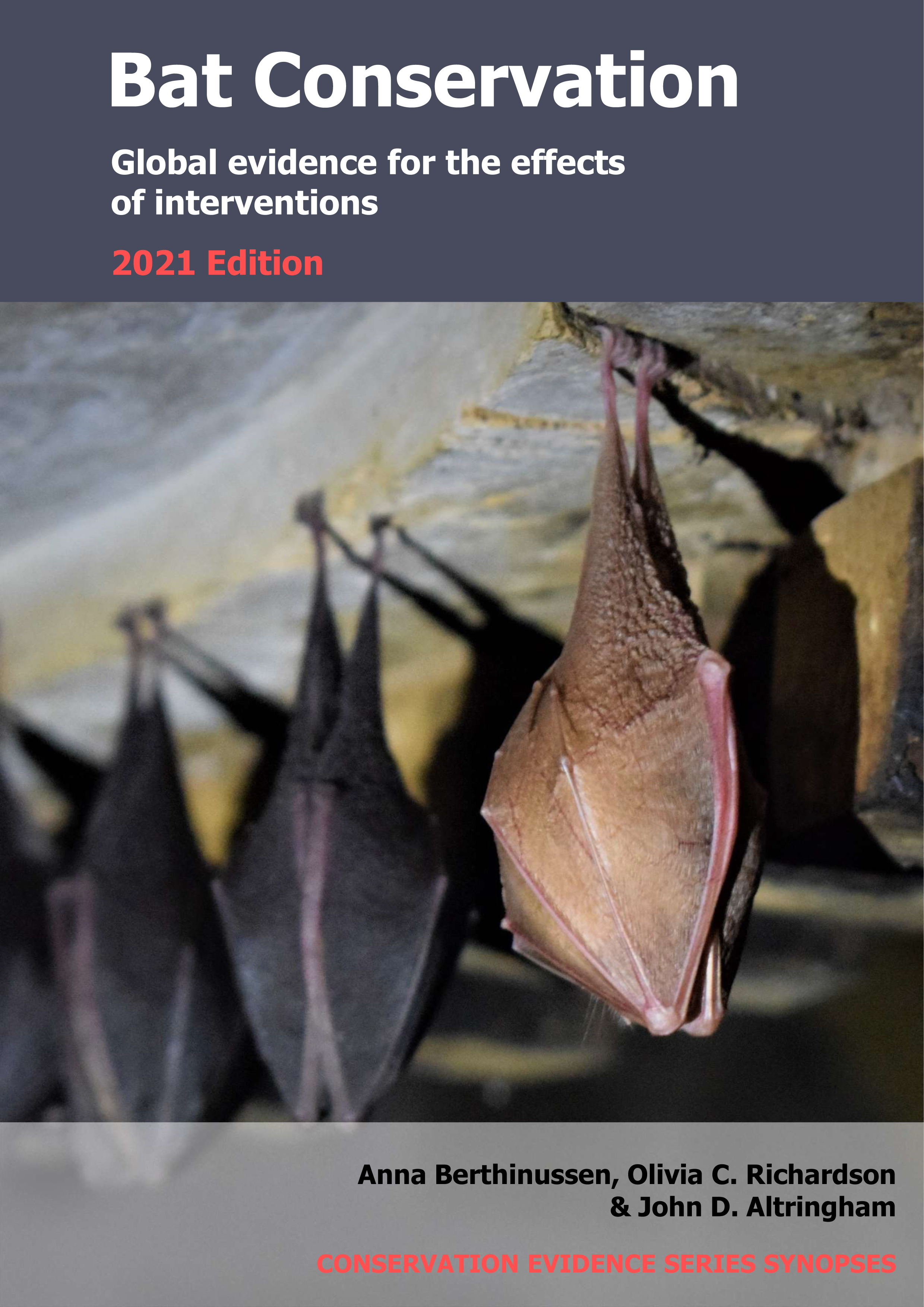Actions to conserve biodiversity
We have summarised evidence from the scientific literature about the effects of actions to conserve wildlife and ecosystems.
Review the evidence from the studies
Not sure what Actions are? Read a brief description.
Search for evidence
e.g. "frogs chytrid"
200 Actions found
Refine
Hide
200 Actions found
Download Actions
| 0 selected |
|
Order results by:
| Action | Effectiveness | Studies | Category | |
|---|---|---|---|---|
|
Keep domestic cats indoors at night Action Link |
No evidence found (no assessment) | 0 |
|
|
|
Use collar-mounted devices on cats to reduce predation of bats Action Link |
No evidence found (no assessment) | 0 |
|
|
|
Treat bat hibernacula environments to reduce the white-nose syndrome pathogen reservoir Action Link |
No evidence found (no assessment) | 0 |
|
|
|
Breed bats in captivity to supplement wild populations affected by white-nose syndrome Action Link |
No evidence found (no assessment) | 0 |
|
|
|
Carry out surveillance of bats to prevent the spread of disease/viruses to humans to reduce human-wildlife conflict Action Link |
No evidence found (no assessment) | 0 |
|
|
|
Decontaminate clothing and equipment after entering caves to reduce the spread of the white-nose syndrome pathogen Action Link |
No evidence found (no assessment) | 0 |
|
|
|
Prevent pollution from sewage treatment facilities from entering watercourses Action Link |
No evidence found (no assessment) | 0 |
|
|
|
Reduce or prevent the use of septic systems near caves Action Link |
No evidence found (no assessment) | 0 |
|
|
|
Introduce or enforce legislation to prevent ponds and streams from being contaminated by toxins Action Link |
No evidence found (no assessment) | 0 |
|
|
|
Use organic pest control instead of synthetic pesticides Action Link |
No evidence found (no assessment) | 0 |
|
|
|
Prevent pollution from agricultural land or forestry from entering watercourses Action Link |
No evidence found (no assessment) | 0 |
|
|
|
Plant riparian buffer strips Action Link |
No evidence found (no assessment) | 0 |
|
|
|
Direct lighting away from bat access points or habitats Action Link |
No evidence found (no assessment) | 0 |
|
|
|
Use 'warm white' rather than 'cool' LED lights Action Link |
No evidence found (no assessment) | 0 |
|
|
|
Use glazing treatments to reduce light spill from inside lit buildings Action Link |
No evidence found (no assessment) | 0 |
|
|
|
Install sound barriers in proximity to bat roosts and habitats Action Link |
No evidence found (no assessment) | 0 |
|
|
|
Adapt bat roost structures to buffer against temperature extremes Action Link |
No evidence found (no assessment) | 0 |
|
|
|
Enhance natural habitat features to improve landscape connectivity to allow for range shifts of bats Action Link |
No evidence found (no assessment) | 0 |
|
|
|
Provide suitable bat foraging and roosting habitat at expanding range fronts Action Link |
No evidence found (no assessment) | 0 |
|
|
|
Manage natural water bodies in arid areas to prevent desiccation Action Link |
No evidence found (no assessment) | 0 |
|
|
|
Retain buffer zones around core habitat Action Link |
No evidence found (no assessment) | 0 |
|
|
|
Retain existing bat commuting routes Action Link |
No evidence found (no assessment) | 0 |
|
|
|
Retain remnant habitat patches Action Link |
No evidence found (no assessment) | 0 |
|
|
|
Retain connectivity between habitat patches Action Link |
No evidence found (no assessment) | 0 |
|
|
|
Retain wetlands Action Link |
No evidence found (no assessment) | 0 |
|
Download Actions
| 0 selected |
|

Bat Conservation - Published 2021
Update 2020
Watch this search
If you are familiar with RSS feeds, please click the button below to retrieve the feed URL:
RSS feed for this searchIf you are unfamiliar with RSS feeds, we would suggest reading this BBC article.
Unfortunately, due to the number of feeds we have available, we cannot provide e-mail updates. However, you could use tools such as Feed My Inbox to do this for you.
What are 'Individual studies' and 'Actions'?
Individual studies
An individual study is a summary of a specific scientific study, usually taken from a scientific journal, but also from other resources such as reports. It tells you the background context, the action(s) taken and their consequences.
If you want more detail please look at the original reference.
Actions
Each action page focuses on a particular action you could take to benefit wildlife or ecosystems.
It contains brief (150-200 word) descriptions of relevant studies (context, action(s) taken and their consequences) and one or more key messages.
Key messages show the extent and main conclusions of the available evidence. Using links within key messages, you can look at the paragraphs describing each study to get more detail. Each paragraph allows you to assess the quality of the evidence and how relevant it is to your situation.
Where we found no evidence, we have been unable to assess whether or not an intervention is effective or has any harmful impacts.





)_2023.JPG)














